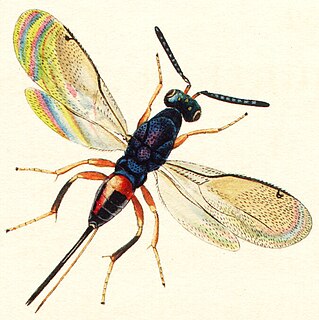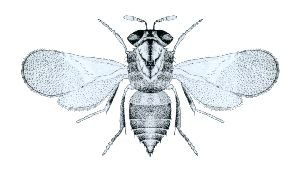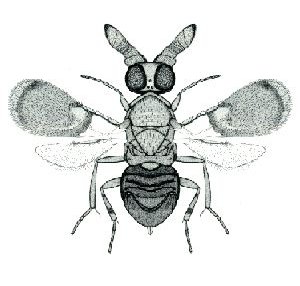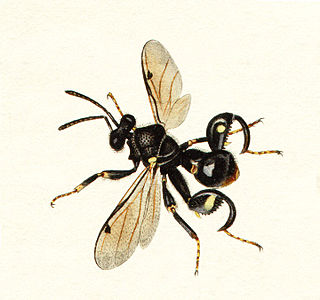
Fig wasps are wasps of the superfamily Chalcidoidea which spend their larval stage inside figs. Most are pollinators but others simply feed off the plant. The non-pollinators belong to several groups within the superfamily Chalcidoidea, while the pollinators are in the family Agaonidae. While pollinating fig wasps are gall-makers, the remaining types either make their own galls or usurp the galls of other fig wasps; reports of them being parasitoids are considered dubious.

Chalcid wasps are insects within the superfamily Chalcidoidea, part of the order Hymenoptera. The superfamily contains some 22,500 known species, and an estimated total diversity of more than 500,000 species, meaning the vast majority have yet to be discovered and described. The name "chalcid" is often confused with the name "chalcidid", though the latter refers strictly to one constituent family, the Chalcididae, rather than the superfamily as a whole; accordingly, most recent publications (e.g.,) use the name "chalcidoid" when referring to members of the superfamily.

The family Agaonidae is a group of pollinating and nonpollinating fig wasps. They spend their larval stage inside the fruits of figs. The pollinating wasps are the mutualistic partners of the fig trees. The nonpollinating fig wasps are parasitic. Extinct forms from the Eocene and Miocene are nearly identical to modern forms, suggesting that the niche has been stable over geologic time.

Torymidae is a family of wasps in the superfamily Chalcidoidea. Most species in this family are small with attractive metallic coloration, and females generally have long ovipositors. Many are parasitoids on gall-forming insects, and some are phytophagous (plant-eating) species, sometimes using the galls formed by other insects. Over 960 species in about 70 genera are found worldwide. They are best recognized in that they are one of the few groups of Chalcidoidea in which the cerci are visible.

The Mymarommatidae, sometimes referred to as False fairy wasps. are a very small family of microscopic hymenopteran insects. Only about half of the known species are living taxa, but they are known from all parts of the world. Undoubtedly, many more await discovery, as they are easily overlooked and difficult to study due to their extremely small size.
Parasitica is an obsolete, paraphyletic infraorder of Apocrita containing the parasitoid wasps. It includes all Apocrita except for the Aculeata. Parasitica has more members as a group than both the Symphyta and the Aculeata combined.

The Eucharitidae are a family of parasitic wasps. Eucharitid wasps are members of the superfamily Chalcidoidea and consist of three subfamilies: Oraseminae, Eucharitinae, and Gollumiellinae. Most of the 55 genera and 417 species of Eucharitidae are members of the subfamilies Oraseminae and Eucharitinae, and are found in tropical regions of the world.

The Trichogrammatidae are a family of tiny wasps in the Chalcidoidea that include some of the smallest of all insects, with most species having adults less than 1 mm in length, with species of Megaphragma having an adult body length less than 300 μm. The over 840 species are placed in about 80 genera; their distribution is worldwide. Trichogrammatids parasitize the eggs of many different orders of insects. As such, they are among the more important biological control agents known, attacking many pest insects.

The Aphelinidae are a moderate-sized family of tiny parasitic wasps, with about 1100 described species in some 28 genera. These minute insects are challenging to study, as they deteriorate rapidly after death unless extreme care is taken, making identification of most museum specimens difficult. The larvae of the majority are primary parasitoids on Hemiptera, though other hosts are attacked, and details of the life history can be variable. Males and females may have different hosts and different life histories.

Encyrtidae is a large family of parasitic wasps, with some 3710 described species in about 455 genera. The larvae of the majority are primary parasitoids on Hemiptera, though other hosts are attacked, and details of the life history can be variable. They are found throughout the world in virtually all habitats, and are extremely important as biological control agents. They may also present as an ecological threat to the population of some species. For example, the endangered Papilio homerus butterfly is parasitized at a rate of 77%. Parasitic wasps are the main contributor to egg mortality in the butterfly species.

The Pteromalidae are a very large family of mostly parasitoid wasps, with some 3,450 described species in about 640 genera. The subfamily-level divisions of the family are highly contentious and unstable, and the family thought to be "artificial", composed of numerous, distantly related groups (polyphyletic). Accordingly, details of their life histories range over nearly the entire range possible within the Chalcidoidea, though the majority are parasitoids of other insects. They are found throughout the world in virtually all habitats, and many are important as biological control agents. The oldest known fossil is known from the Early Cretaceous

The Perilampidae are a small family within the Chalcidoidea, composed mostly of hyperparasitoids. The family is closely related to the Eucharitidae, and the eucharitids appear to have evolved from within the Perilampidae, thus rendering the family paraphyletic. As presently defined, at least 15 genera and 270 species are described worldwide. They are often brilliantly metallic, with robust mesosomae and a small, triangular metasomae. They are generally very strongly sculptured. The prothorax is typically very broad and disc-like, and the labrum is multidigitate, a feature shared with the Eucharitidae.

The Chalcididae are a moderate-sized family within the Chalcidoidea, composed mostly of parasitoids and a few hyperparasitoids. The family is apparently polyphyletic, though the different subfamilies may each be monophyletic, and some may be elevated to family status in the near future. As presently defined, there are over 85 genera and over 1460 species worldwide. They are often black with yellow, red, or white markings, rarely brilliantly metallic, with a robust mesosoma and very strong sculpturing. The hind femora are often greatly enlarged, with a row of teeth or serrations along the lower margin.

The Leucospidae are a specialized group of wasps within the superfamily Chalcidoidea, that are ectoparasitoids of aculeate wasps or bees. They are typically mimics of bees or stinging wasps, often black with yellow, red, or white markings, sometimes metallic, with a robust mesosoma and very strong sculpturing. The hind femora are often greatly enlarged, with a row of teeth or serrations along the lower margin as in Chalcididae. The wing has a longitudinal fold. The female ovipositor is sometimes short, but if not, it is recurved and lies along the dorsal side of the metasoma, a unique feature. The males are also unusual, in the fusion of many of the metasomal segments to form a capsule-like "carapace".

Eupelmidae is a family of parasitic wasps in the superfamily Chalcidoidea. The group is apparently polyphyletic, though the different subfamilies may each be monophyletic, and may be elevated to family status in the near future. As presently defined, there are over 905 described species in 45 genera. The larvae of the majority are primary parasitoids, commonly on beetle larvae, though many other hosts are attacked, including spiders, and details of the life history can be variable. They are found throughout the world in virtually all habitats.

The Ormyridae are a small family of parasitic wasps in the superfamily Chalcidoidea. They are either parasitoids or hyperparasitoids on gall-forming insects, primarily cynipid wasps and tephritid flies. The 120 or so species in three genera are cosmopolitan, except almost entirely absent from South America.

The Tetracampidae are a small family of parasitic wasps in the superfamily Chalcidoidea. They are parasitoids of phytophagous insects, primarily flies. The 44 species in 15 genera are almost entirely absent from the New World.
Signiphoridae is a small family of parasitic wasps in the superfamily Chalcidoidea. The roughly 80 species are placed in four genera.

The Rotoitidae are a very small family of rare, relictual parasitic wasps in the superfamily Chalcidoidea, known primarily from fossils. Only two extant species are known, each in its own genus, one from New Zealand and one from Chile, and little is known about their biology. Females of the Chilean species, Chiloe micropteron, have their wings reduced to tiny bristles. Most fossil species are known from the Taimyr amber of Russia and Canadian amber, but one species, Baeomorpha liorum is known from the Burmese amber.
Marina Dmitrievna Zerova was an Ukrainian entomologist. Several insects have been named after her. She became Doctor of Biological Sciences (1980), Professor (1989) and Honored Worker of Science and Technology of Ukraine (2003). In 1981 she was awarded the Award of the National Academy of Sciences of Ukraine named after DK Zabolotny.















